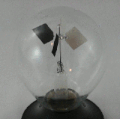Light mill
Jump to navigation
Jump to search
Nederlands: De radiometer van Crookes is een lichtmolentje dat bestaat uit glazen bol met daarin (vier) metalen wieken die op een verticale draaias gemonteerd zijn.
English: The Crookes radiometer, also known as the light mill or solar engine, consists of an airtight glass bulb, containing a partial vacuum. Inside are a set of vanes which are mounted on a spindle. The vanes rotate when exposed to light. The reason for the rotation has been the cause of much scientific debate.
Deutsch: Eine Lichtmühle, auch als Radiometer oder Lichtrad bezeichnet, ist eine dekorative Glaskugel, in deren Inneren sich ein bei Lichteinfluss drehendes Flügelrad befindet, das aus meistens vier Plättchen besteht, die auf einer Seite geschwärzt sind.
Please note:
- Crookes incorrectly suggested that the force was due to the pressure of light. In 1901, with a better vacuum pump, Pyotr Lebedev showed that in fact, the radiometer only works when there is low pressure gas in the bulb, and the vanes stay motionless in a hard vacuum. Finally, if light pressure were the motive force, the radiometer would spin in the opposite direction as the photons on the shiny side being reflected would deposit more momentum than on the black side where the photons are absorbed. The actual pressure exerted by light is far too small to move these vanes but can be measured with devices such as the Nichols radiometer.
- Both Einstein's and Reynolds's forces appear to cause a Crookes radiometer to rotate, although it still isn't clear which one is stronger.
Source: en:Light mill
Radiometer of Crookes[edit]
-
Crookes radiometer
-
Radiometer Crookes - Oberweißbach-Thüringen
-
Inside a Light Mill




